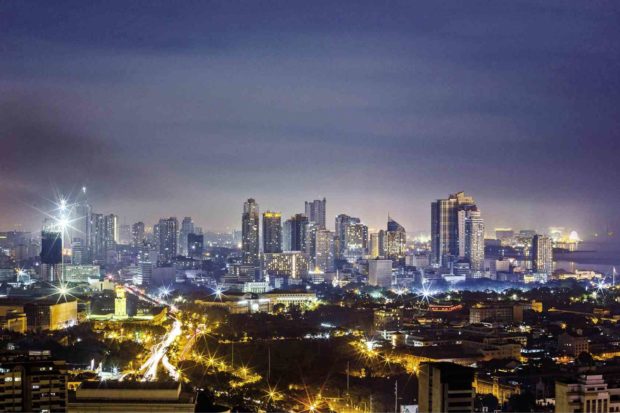COVID-19 cases up in some Metro Manila LGUs

Metro Manila skyline at night (INQUIRER FILE PHOTO / JILSON SECKLER TIU)
MANILA, Philippines — While all areas in Metro Manila remain at minimal risk, the number of active cases in six cities and one municipality has recorded a positive growth rate during the past week, according to the Department of Health (DOH).
The local government units (LGUs) that registered positive one-week growth rates from April 12 to April 18 were Pateros (100 percent), Navotas (80 percent), Las Piñas (27.3 percent), Parañaque (16.4 percent), Taguig (7.5 percent), Muntinlupa (14.3 percent) and Marikina (10 percent). The DOH did not provide a specific number of cases in each area.
Active COVID-19 infections in these cities as of April 18 were as follows: 18 in Pateros, 74 in Navotas, 275 in Las Piñas, 413 in Parañaque, 365 in Taguig, 196 in Muntinlupa and 271 in Marikina.
There were no data covering the previous day that could be used for comparison because the DOH stopped issuing daily bulletins on March 6 and had since released weekly reports instead.
On Wednesday, the nationwide case tally of new COVID-19 cases more than doubled to 365, bringing the total number of infections to 3,683,732 since the start of the pandemic. This reflected a significant jump from Tuesday’s daily count of 158 cases, which was the lowest single-day tally since Dec. 21 last year, when the DOH recorded 168 infections.
The total bed and intensive care unit (ICU) utilization rates increased in Valenzuela City due to reduced number of dedicated beds for COVID-19 patients, based on April 16 data.
Meanwhile, overall hospital admissions for COVID-19 showed a “slight increase” in Pasig City.
Projections from the DOH’s FASSSTER team showed that active cases may climb to a high of 300,000 nationwide and 500,000 in Metro Manila by the middle of May if compliance to minimum public health standards decreases to about 30 to 50 percent.
FASSSTER—which stands for Feasibility Analysis of Syndromic Surveillance using Spatio-Temporal Epidemiological Modeler—is composed of experts who analyze, survey and detect diseases.
‘COVID-proof’ polls
Meanwhile, voters who may have COVID-like symptoms on May 9, Election Day, may still cast their votes at makeshift polling areas but they would be unable to review the receipts to see if the names they shaded on the ballot were read accurately by the vote counting machines (VCMs).
This was a “challenge’’ pointed out during a forum held by the Ateneo School of Government on Tuesday on how to make the elections “Covid-proof.”
“Since these voters will not be in the clustered precinct and [voting] receipts are not allowed to be taken out of clustered precincts, they will not be able to double check the receipts to see if it reflects [the names] on the ballot that was fed [into the vote counting machines],” said lawyer Leylann Manuel, president of the employees union of the Commission Elections (Comelec).
Under Comelec Resolution No. 10727, voters will be screened by a medical personnel before proceeding to the assigned clustered precinct. Those found to have fever, or a temperature of 37.5 degrees Celsius or up, will be asked to cast their vote at the isolation polling place (IPP).
According to Manuel, this would pose a “slight problem” for the voter, similar to the case of detained persons who were still allowed to cast their votes in previous elections.
“[It] will be like how detained people vote—ballots were brought in detention facilities, fed into the machine and then sent to the clustered precincts. And so they were not able to see the receipt anymore,” Manuel recalled.
The review of the voting receipt, formally called voter verification paper audit trail or VVPAT, is part of the current voting process and is a key component in auditing the vote count.
‘No disenfranchisement’
Still, Manuel said there “would be no disenfranchisement” because registered voters, regardless of symptoms, will be allowed to vote on May 9.
He also said that the Comelec en banc may issue further guidelines on the voting process at IPPs in the coming days.
At the same online briefing, Health Undersecretary Maria Rosario Vergeire asked the Comelec to appoint “safety officers” who will facilitate the management of voters with COVID-like symptoms.
The DOH spokesperson said these officers should refer probable COVID-19 patients to the concerned LGU, which in turn will isolate, test and later release the patients if found negative for the coronavirus.
These safety officers will be different from the medical personnel assigned to screen the temperatures of voters as well as the marshals tasked to police those who fail to adhere to health protocols while inside the voting areas, Vergeire said.
Stay in isolation
She reminded individuals confirmed to have COVID-19 not to leave their isolation spaces, whether in the hospitals, facilities or their own homes, on Election Day.
“I don’t think that it would be possible that they would go out of the hospital to vote—they’re supposed to be isolated and they’re being managed in the facility—unless Comelec provides alternative mechanisms or processes for them so they can cast their votes as well,” Vergeire said.
Comelec spokesperson James Jimenez earlier clarified that IPPs are for individuals who show COVID-like symptoms and not for patients already confirmed to have COVID-19 and supposed to be in quarantine.
COVID-19 patients have no choice but to give up their right to vote on May 9, after the Comelec earlier turned down proposals from health officials to create options for such voters, such as voting online or via text messaging.
A study by the Ateneo School of Government published in January this year estimated that the government would need about P17.5 billion in additional funds to “COVID-proof” the May 9 elections.
RELATED STORIES
DOH says COVID surge by May if protocols aren’t met is just a projection
14 areas under Alert Level 1 having ‘gradual rise’ in COVID-19 cases
Duque: PH likely to stay under Alert Level 1 until Duterte’s term ends